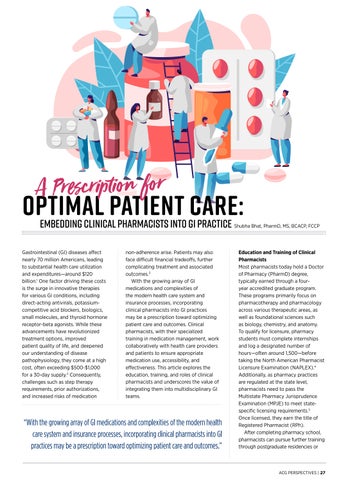A P rescription for
OPTIMAL PATIENT CARE: EMBEDDING CLINICAL PHARMACISTS INTO GI PRACTICE
Shubha Bhat, PharmD, MS, BCACP, FCCP
Gastrointestinal (GI) diseases affect nearly 70 million Americans, leading to substantial health care utilization and expenditures—around $120 billion.1 One factor driving these costs is the surge in innovative therapies for various GI conditions, including direct-acting antivirals, potassiumcompetitive acid blockers, biologics, small molecules, and thyroid hormone receptor-beta agonists. While these advancements have revolutionized treatment options, improved patient quality of life, and deepened our understanding of disease pathophysiology, they come at a high cost, often exceeding $500-$1,000 for a 30-day supply.2 Consequently, challenges such as step therapy requirements, prior authorizations, and increased risks of medication
non-adherence arise. Patients may also face difficult financial tradeoffs, further complicating treatment and associated outcomes.3 With the growing array of GI medications and complexities of the modern health care system and insurance processes, incorporating clinical pharmacists into GI practices may be a prescription toward optimizing patient care and outcomes. Clinical pharmacists, with their specialized training in medication management, work collaboratively with health care providers and patients to ensure appropriate medication use, accessibility, and effectiveness. This article explores the education, training, and roles of clinical pharmacists and underscores the value of integrating them into multidisciplinary GI teams.
“With the growing array of GI medications and complexities of the modern health care system and insurance processes, incorporating clinical pharmacists into GI practices may be a prescription toward optimizing patient care and outcomes.”
Education and Training of Clinical Pharmacists Most pharmacists today hold a Doctor of Pharmacy (PharmD) degree, typically earned through a fouryear accredited graduate program. These programs primarily focus on pharmacotherapy and pharmacology across various therapeutic areas, as well as foundational sciences such as biology, chemistry, and anatomy. To qualify for licensure, pharmacy students must complete internships and log a designated number of hours—often around 1,500—before taking the North American Pharmacist Licensure Examination (NAPLEX).4 Additionally, as pharmacy practices are regulated at the state level, pharmacists need to pass the Multistate Pharmacy Jurisprudence Examination (MPJE) to meet statespecific licensing requirements.5 Once licensed, they earn the title of Registered Pharmacist (RPh). After completing pharmacy school, pharmacists can pursue further training through postgraduate residencies or
ACG Perspectives | 27
